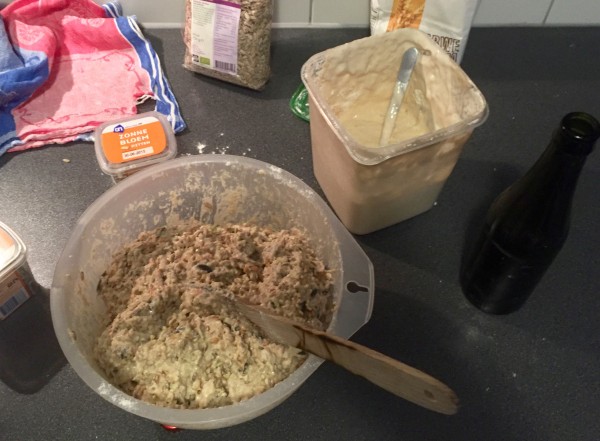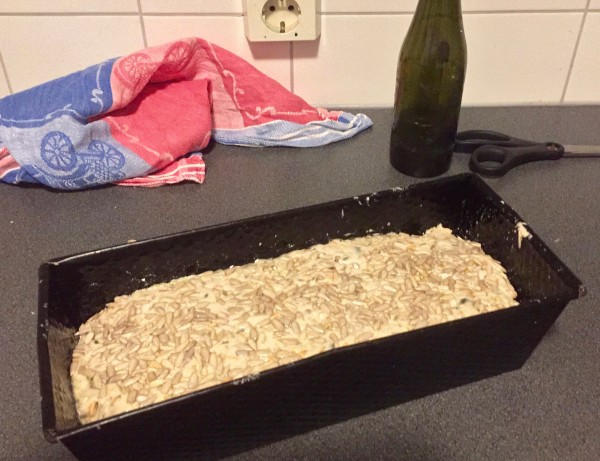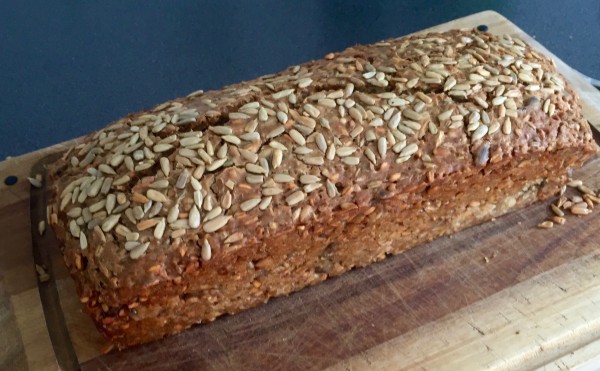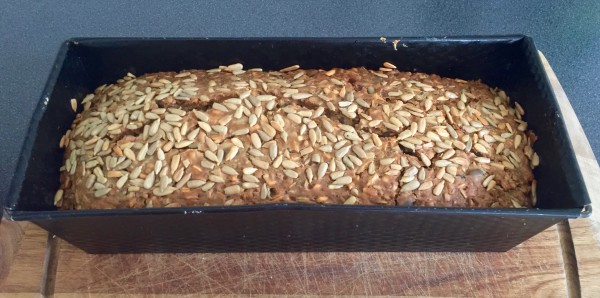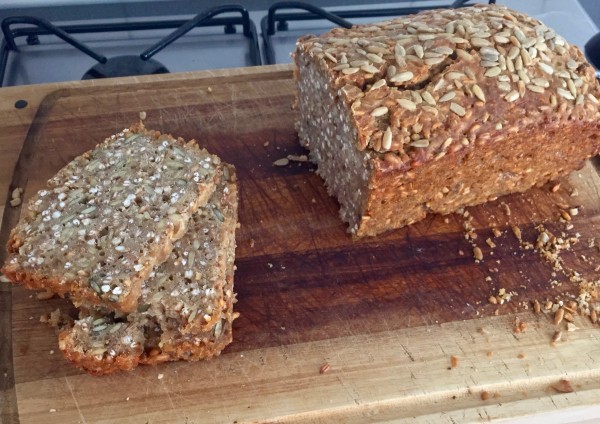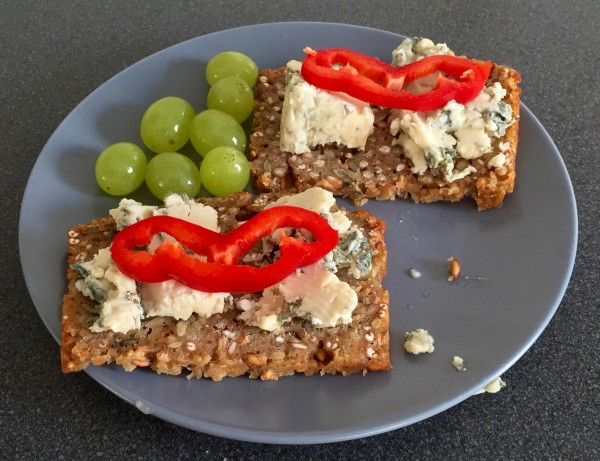Here’s a thing that I did: bread with beer.
Sure, you say, what’s so special about that? – everybody and their mother has done that.
Well, I enjoy whole grain, multi grain sour-dough bread, so I bake those roughly weekly. My basic recipe is approximately 500 g sourdough starter, 300-400 g flour (wheat flour, oatmeal, …), 100 g bird seeds (sunflower seeds, pumpkin seeds, …), and 500 g whatever-the-fuck-I-feel-like (chickpeas, olives, grains, …). Add to that a bit of liquid, salt and boom! bread.
Today I was baking day, so a bunch of hours ago I took out and fed my sourdough starter, and soaked 500 g grains (spelt, rye, and buckwheat) in a bit of white wine I use for cooking.
Not much left in the bottle and being too lazy to fetch another bottle, I instead decided to use beer. Normally, I’d just use some boring pilsner like a Heineken, Bavaria or Grolsch, but today my eyes fell on another bottle, and I made this:
Here’s where it gets interesting. The beer has no label. That’s because it is an experimental brew that was made in a very small batch (5000 bottles or 1650 liters).
The beer in question is test brew 24, which later resulted in Thisted Bryghus‘ Julestenøl (Christmas Stone Beer) – Thisted is best known for their excellent English licorice Baltic porter Limfjordsporter. Test brew is a top-fermented beer which during the brewing process has lava rocks added to it.
This is different from the German steinbier tradition in which hot rocks are added and give a smokey taste – try the unspellable and unpronounceable but very excellent Aecht Schlenkerla Rauchbier for an example of this tradition. Complete the set with a Ardbeg 10 and a Cohiba Siglo IV and you might be able to imagine how I spent a lot of my time as a student 🙂
Julestenøl and test brew 24 instead uses lava rocks which are extremely porous, giving the sugar in the mash a lot of surface area to caramelize. Which is exactly what it does, yielding a caramel-like taste. That’s probably why it was launched as a Britmas beer.
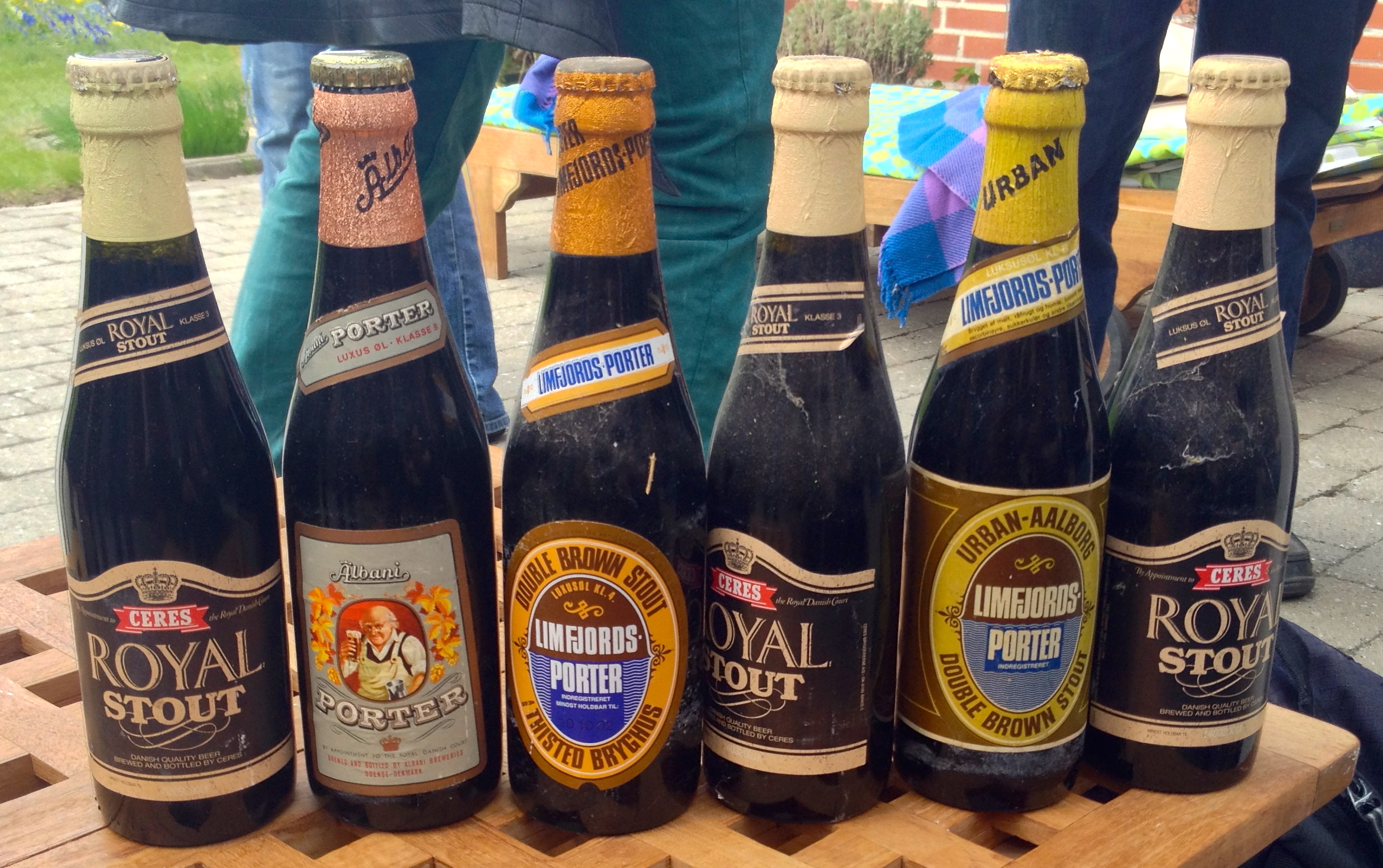 Well, this was all more or less exactly 10 years ago, so the beer has also been stored for 10 years. It’s been kept reasonably well, but not excellently, and the fairly low alcohol (estimated at around 7.1% when it was fresh, likely more now as it is unfiltered and unpasteurized allowing it to develop and ferment in the bottle) means it does not really stay good this long. Already a couple years ago I declared it was more or less EOL. That’s not necessarily the case for beer – this row of beers features beers from 10 to at least 30 years old (including a very special treat, a 25+ years old Limfjordsporter). We were so lucky to taste the beers during Black Spring 2013 where Niels from Aarhus Bryghus not only did all the perpetuation including cooking, but also treated with gems from his stash. Below is a row of Chimay Bleue I tasted at Kulminator in 2007 going all the way back to 1982.
Well, this was all more or less exactly 10 years ago, so the beer has also been stored for 10 years. It’s been kept reasonably well, but not excellently, and the fairly low alcohol (estimated at around 7.1% when it was fresh, likely more now as it is unfiltered and unpasteurized allowing it to develop and ferment in the bottle) means it does not really stay good this long. Already a couple years ago I declared it was more or less EOL. That’s not necessarily the case for beer – this row of beers features beers from 10 to at least 30 years old (including a very special treat, a 25+ years old Limfjordsporter). We were so lucky to taste the beers during Black Spring 2013 where Niels from Aarhus Bryghus not only did all the perpetuation including cooking, but also treated with gems from his stash. Below is a row of Chimay Bleue I tasted at Kulminator in 2007 going all the way back to 1982.
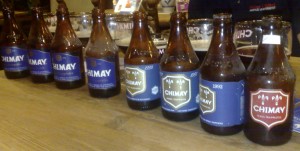 So, test brew 24 was all ruined for consumption. Well, except for bread that is! I used around ⅔ of the bottle as liquid for a bread that is now cold-rising and waiting to get in the oven tomorrow.
So, test brew 24 was all ruined for consumption. Well, except for bread that is! I used around ⅔ of the bottle as liquid for a bread that is now cold-rising and waiting to get in the oven tomorrow.
Whenever I bake, I also feed my sourdough starter. It makes sense, so I retain a steady supply. After several milliseconds of consideration, I used the remaining third of the bottle (and a dap of flour) for feeding the starter. Now, I’m hoping goodness from the beer will get added to my sourdough starter for even better breads in the future.
In any case, now I have a bread baked with a 10 years vintage bottle of beer from a super-rare and small test brew and hope it will turn out great. Next week or the week thereafter, I’ll be able to test if the sourdough starter has taken taste from the beer.
Here’s the bread in various stages of decomposition. I’ll leave further steps to the imagination and dodgy German raunchy entertainment sites.
